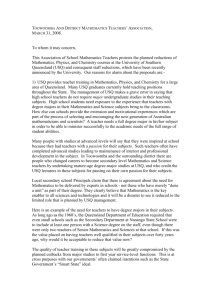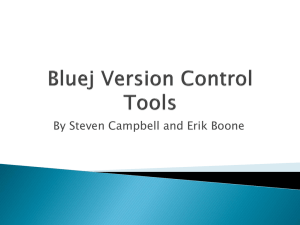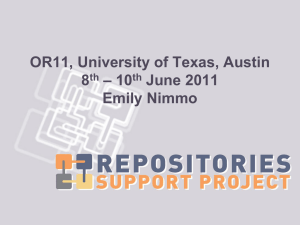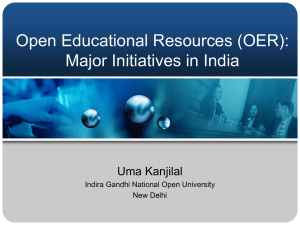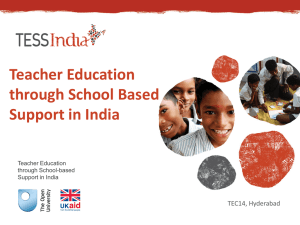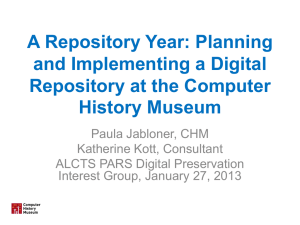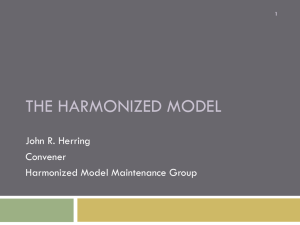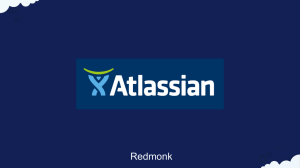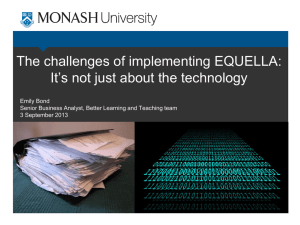University of Southern Queensland
advertisement
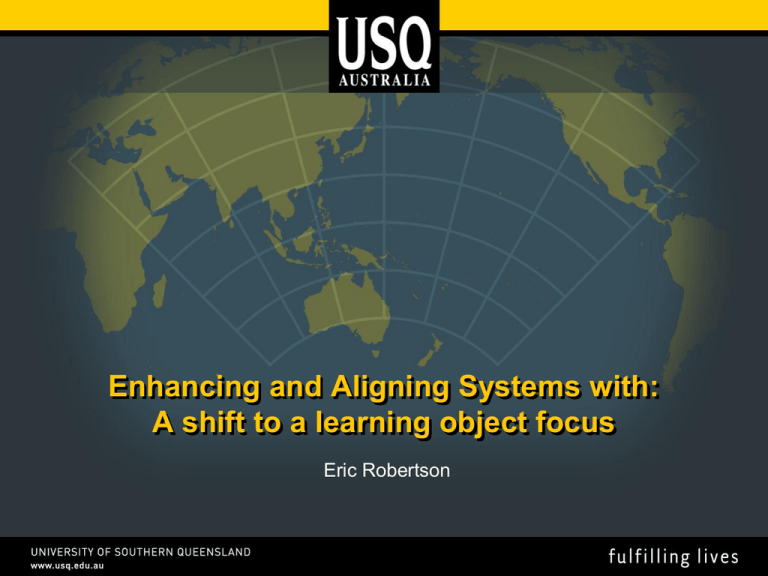
Enhancing and Aligning Systems with: A shift to a learning object focus Eric Robertson Introduction • Journey to create a Learning Object Repository encompassing 13 objects from 13 different sources with different requirements, workflows and aspirations • Presentation in two parts • Part 1 – Need for the LOR – Scope of the LOR – Implementation (we are only at the start of this process) • Part 2 – Demo of the Lecture Recordings • The Future and the opportunities Photo caption Source: Supplier name goes here About USQ • • • • • • Leader in open and flexible (studentfocussed) education Over 26,000 students representing over 12,000 EFTSL Four Queensland campuses – USQ Toowoomba, USQ Fraser Coast, USQ Springfield and QCWT in Stanthorpe 75% of students study away from campus, in over 70 countries Major educational partners and study centres worldwide Regionally relevant research in areas including flexible education, sustainability, agricultural and civil engineering, rural health and public memory USQ Campus locations Why this project • The broader Integrated StudyDesk (ISD) project was established to provide a learning and teaching environment that will build the capacity and capability of academic staff in order to facilitate improved learning experiences for students. • Central to this is to align and enhance systems for student learning resources and learning object storage. • Everyone used Studydesk, Staffdesk and community systems as a dumping ground for files • No copyright management was performed • “Patchy” attribution of content was done • So it was decided a LOR was required • No object lifecycle, limited metadata, no workflow • No stats or basic controls http://uncyclopedia.wikia.com/wiki/Fi le:Sheriff_toon_of_un.jpg • We had a working Course Reading Collection Major Objectives of the LOR • The major objectives of the Repository sub-project, in summary, are: • Design and establish one or more web responsive Learning Object Repositories (LORs) • Develop automated, embedded learning object lifecycle workflow to support learning object creation, submission, approval, storage and rights management. • Embed digital rights management which provides access, reporting and automated workflow relevant to the nature of the object; viz. facilitates both OERs and restricted license objects. • Integrate the LOR with University Learning Management Systems USQStudyDesk, USQStaffDesk and USQOpenDesk. • Build a framework for learning object discovery and analytics • Staff Training and PD What does all this mean?? • Create repository collections – House objects currently in Moodle • Use EQUELLA software • Links to/from Moodle • Single Discovery layer • Benefits – Centrally stored – Discovery, sharing, re-use – Copyright management and reporting – Reduced file storage – Quicker course migration Where is the data/files?? • Sources of data Collection Title Description Moodle Learning Objects Number of resources in Moodle and is required to be stored in a repository. Variety of formats and sizes. Should be made available to all 3 Moodle Environments. Published ICE Content Published ICE Content to be made available through Moodle environments. This is a point in time release of the finalised ICE content for a given semester. Lecture Recordings Scope is Camtasia Relay lecture recordings for use in StudyDesk Courses Photography Cumulus is currently the repository for USQ photographs. Image size is currently growing exponentially. Needs a repository for tagging, accessing and stored in high risk personal hard drive setup. Graphics Macromedia suite files (InDesign, Flash, Illustrator, Photoshop). Finished product/source files to be tagged, stored and archived. Screen Rights Australia Recordings Recordings of various Film, Radio and Television broadcasts USQ produced Digital Media USQ productions Past Exams Should be a published exam repository for all exams with some publically accessible (past exams functionality) OER (USQ Content published elsewhere) Open Education Resources process to be defined and currently no actual collection exists. Note this is an OER out collection (push to OER) OER Discovery Harvesting content from world’s best practice OER repositories (LORN) to provide a guide for discovery to academics at USQ. Not currently implemented. Personal Repository For Systems like Mahara (ePortfolio). This will enable professional storage of content against a staff/student profile ICE source repository For the creation and editorial process of ICE. Note possibly out of scope and will need a significant project for the implementation Gaps in Knowledge WE REALLY DID NOT UNDERSTAND OUR OBJECTS AND OUR USE OF THEM • Copyright Process around Learning Objects at USQ (CAL reporting, DRM, Portal considerations and self-submission process and monitoring) • Discovery and Use of Learning Objects at USQ- Repository Considerations and Policy Implications (Who can discover and access what content) • Administrative Repository Considerations (e.g. Photography, Graphics and USQ produced digital media) and it’s Integrations with L&T content • Impacts of OER and how this could be implemented at USQ • USQ Metadata development standard (review existing documentation and amend) Learning Objects Audit Audit to examine the following aspects the learning objects currently in use across a sample of courses and systems. • StudyDesk – Student facing courses • StaffDesk – Staff facing courses (L&T objects) • Community Desk • Open Courseware • Lecture Capture (Relay) published through StudyDesk • Non-Lecture Recordings • Digital Media Content such as USQ produced videos, Multimedia, Graphics and Photography • Other L&T Content – USQ produced content for SPARS, LTQ Staff Portal etc. Learning Objects Audit Cont. • Initial themes have emerged from the Learning Object Audit: – The large majority of Learning Objects currently in StudyDesk have 3rd party copyright i.e. not USQ produced. – The Majority of these Learning Objects are not correctly attributed and have no digital rights management attached. There are many complex learning objects which are compilation files (e.g. PowerPoint, lecture recordings and PDF/Word documents) which contain a variety of copyrighted components. These have limited attribution and digital rights management notices. Other Requirement Gathering Activities • Internal Stakeholder meetings • External sector scan (survey) . Analyse current practices in Learning Object Repositories and rights management practices across the Australian Higher Education sector. Key Recommendations A Learning Objects Collection be created within the EQUELLA repository for the storage of learning and teaching objects. • Staff upload items into the repository from a Moodle frame, selecting the appropriate copyright category and completing minimum metadata. • Objects which require copyright permissions feed into a workflow to repository/copyright support staff. • Staff agree to a copyright disclaimer at the upload of each item. Copyright/Repository support staff check on copyright compliance of objects in the repository through: • Copyright breach detection reports • Conducting monthly random audits of 5% of new objects loaded in the repository. A range of copyright and learning materials development support tools be created including: • Online copyright decision matrix • Best practice user guidelines incorporating resource selection guidance, copyright information and learning materials exemplars • Copyright application templates • Copyright FAQs Copyright and resource selection training be developed and included in core Academic skills training and induction programs. Academic staff are encouraged to use USQ owned, OER and Creative Commons licensed objects. This can be enabled through: • Creation of a USQ photographic collection within EQUELLA • Creation of a Digital Media collection within EQUELLA • Creation of an OER portal (with links to OER resources, databases and repositories external to USQ) Staff responsibilities • Academic staff – Load objects into repository • Complete necessary metadata fields – Decide on copyright • Unsure option – Link to object from Moodle • Support staff – Repository/Copyright team – Moderate unsure items – provide advice – Copyright permission applications – Object audits – 5%/month – Copyright breach detection reports • System – Copyright reporting – Attribution – Copyright Warning notices Demonstration • Lecture recordings • Contribution wizard • Moodle frame Initial development only Future Directions To Trial in November – LOR Collection – Lecture Recordng and Presentation Collection To Trial in early 2014 – Photography – Discovery System – USQ Media Bulk Load of Materials to be done mid to late 2014
